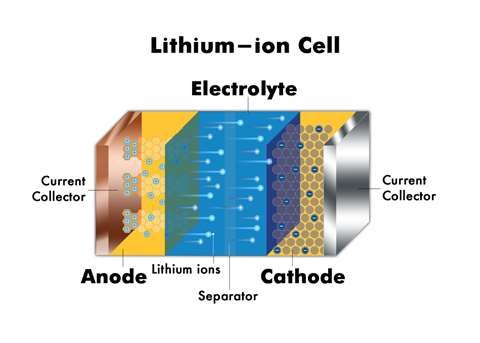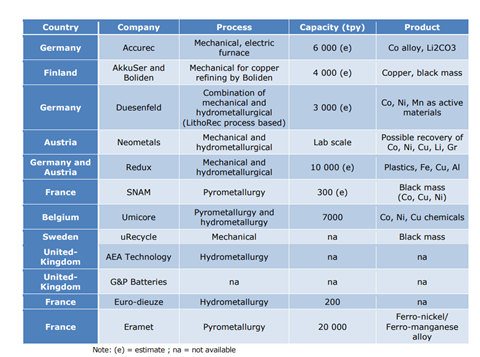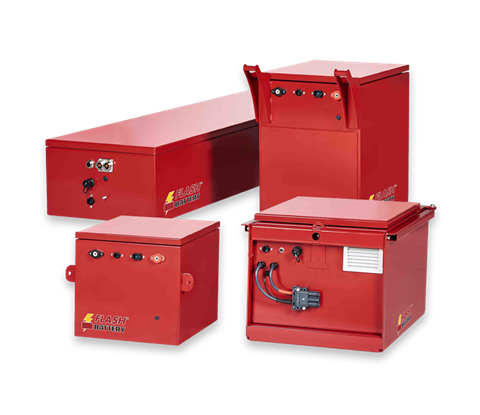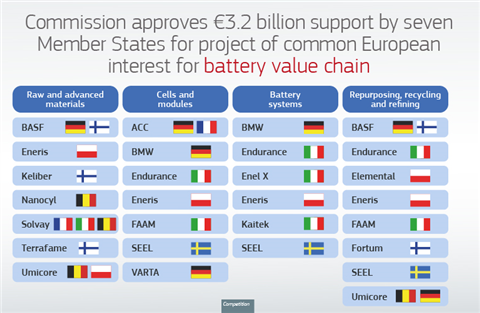Lithium battery recycling: where does the industry stand?
29 March 2023
Flash Battery, an Italy-based specialist in lithium ferro-phosphate (LFP) batteries for off-highway and industrial applications, explains how lithium batteries have to be disposed of and recycled at the end of their operational life.
This article explores the current aspects of disposal and recycling as well as new, more sustainable lithium technologies.
Lithium batteries and their structure
The disposal and recycling of batteries in a safe and efficient is becoming a topical subject, not only from an ethical point of view linked to circular economy, but also because lithium-ion batteries used in modern mobility contain various precious metals and other substances which if not suitably treated could be harmful to the environment.
The recovery of minerals used in batteries will also help with increasing battery production demand, for which the mining limits of such materials are not enough (currently 35% and 25% of mined lithium and cobalt respectively is used to produce lithium batteries [1]).
 Composition of a lithium-ion battery cell
Composition of a lithium-ion battery cell
A lithium-ion cell contains different materials and is composed of:
- a cathode– the positive pole of the battery made of a cathode active material (such as LFP, NMC, LMO, LCO) and a current collector (usually aluminium)
- an anode– the negative pole of the battery made of an anode active material (such as graphite, carbon, LCO) and a current collector (usually copper)
- a separator– usually polymer or ceramic placed between the cathode and anode to provide insulation and prevent internal short circuits
- the electrolyte (containing a lithium salt e.g. LiPF6) that fills the entire cell volume, dampening the electrodes and enabling the transport of ions from anode to cathode and vice versa, passing through the holes in the separator.
- additives which facilitate the transport of lithium ions from one electrode to the other during cell charging/discharging processes, conserving the electrodes themselves
The development of new generations of cells is therefore carefully considering the issue of materials shortages by bringing to market solutions that, for example, have a reduced percentage of cobalt, a material that among other things has a high environmental impact.
There are however also lithium chemicals which are completely cobalt-free, as for example Flash Battery’s lithium ferro-phosphate (LFP) technology. The company focused on LFP also because it best suits the needs of the industrial sector; according to Flash Battery, it is the safest and most stable technology to be sourced on the market, it is available in large-capacity formats, and it also has an exceptionally long lifetime (over 4000 recharging cycles).
Recycling around the world and current regulations
Europe is not yet among the major players in recycling; currently most spent batteries are directed to China and South Korea: in 2018, 97 000 tonnes of lithium batteries were recycled, of which 67 000 in China, 18 000 in South Korea, and only the remaining amount in Europe.
It is estimated that in 2030 it will be possible to recover between €400 and €500 million per year (at current prices), considering aluminium, cobalt, nickel and lithium alone [2]. It is also estimated that in 2025 spent batteries will constitute approximately 800 000 tonnes of minerals to be disposed of and recycled.
Currently, the lithium battery disposal and recycling process is mainly driven by the market value of their components, and their availability in recycling centres. For this reason, in Europe and especially Germany aluminium, copper and cobalt are the elements of major interest, as they are recovered in the form of ‘black mass’ metal alloys (mix of everything smelted) requiring additional steps to produce material that can be used directly for new batteries.
 Assessment of recycling capability in Europe in 2019 (from Lebedeva et al, 2017; Dallöf et al, 2019; Lv et al., 2018; Neometals, 2019; Redux, 2019; Umicore, 2019; uRecycle, 2019)
Assessment of recycling capability in Europe in 2019 (from Lebedeva et al, 2017; Dallöf et al, 2019; Lv et al., 2018; Neometals, 2019; Redux, 2019; Umicore, 2019; uRecycle, 2019)
In China and South Korea lithium is mainly recovered in the form of lithium carbonate (Li2CO3); indeed 70% of studies into recycling to date are carried out by China and South Korea, where all active materials can be recycled very efficiently, and the total recovery of materials is currently already higher than 90% [3].
The ideal process for recycling lithium-ion batteries should be able to recycle almost all of the battery components, and it is expected that in the near future more than 95% of the components will be recycled.
Truth be told, the world of lithium-ion batteries is still relatively young and, since these batteries last a long time, at the moment the volume of batteries to be recycled is still very low which does not justify significant investments in this area.
However, main players in the market are taking steps to produce in line with recycling principles, are researching materials that are easier to recycle, and are joining recycling organisations in national territories.
A new European Battery Regulation is just around the corner (entry into force expected by the end of 2023); in the meantime, in the European Union the collection and recycling of batteries and accumulators is regulated by Directive 2006/66/EC that indicates that all member states must adopt the measures required to optimise and encourage the sorting of waste into separate categories, preventing these products from being disposed of as part of dry waste.
In Italy for example, Flash Battery is a member of the National Collection & Recycling Consortium (COBAT) which is responsible for the management, disposal and recycling of batteries and accumulators.
Italian companies registered with COBAT are held to pay quarterly contributions that are proportional to the number of batteries they place on the Italian market, which will go to funding a battery recycling and treatment facility to get off the ground in years to come.
However, an aspect not to be underestimated concerns the recycling of batteries placed on foreign markets, whose responsibility currently lies with the importer and not the manufacturer.
The development of more sustainable lithium technologies
In Europe, Directive 2006/66/EC currently has the objective of recycling a minimum of 50% of spent lithium batteries by average weight, funding their collection, treatment and ultimately recycling. Ensuring long-term sustainability will however require reaching the 95% target mentioned previously and that’s precisely one of the reasons why a new European battery regulation is being developed.
As a matter of fact, in the years to come the new lithium technologies will be implemented according to precise criteria in terms of a sustainable design, by avoiding the use of materials that harm the environment (e.g. cobalt) and by optimising or eliminating production processes that are particularly polluting. Future batteries will also need to be designed to facilitate an easy dismantling and an efficiency recycling.
 Lithium batteries by Flash Battery for industrial/off-highway applications
Lithium batteries by Flash Battery for industrial/off-highway applications
Developing lithium batteries that are increasingly sustainable is also the mission of Flash Battery.
In 2022, the company obtained ISO14001 environmental certification for its continuous investment in research into efficiency-and sustainability-oriented materials, skills and processes. But the attention to sustainability passes first and foremost through the study of the product itself. As Marco Righi, founder and CEO of Flash Battery, explained: “It is clear that the research area takes on a central value for a company like ours, called on to compete in a relatively young and all-innovation-oriented market. The added value given by our R&D and custom departments -which include more than the 35% of our staff - is very important, not only because it allows us to anticipate the needs of our customers by designing lithium batteries and systems at the cutting edge of technology, but also allows us to study solutions that are increasingly careful not to impact negatively on the environment. How? By continuously investing in research on new, highly efficient materials, in skills oriented towards sustainability and in constant technical and electronics developments”.
Europe’s commitment to recycling lithium batteries
Europe is moving fast towards creating its own batteries value chain, with recycling of materials at its heart. As a matter of fact, the EU commitment does not stop with the creation of the new European battery regulation but involves a large investment in research.
In recent years, the European Commission has in fact approved, based on the EU rules on support to member countries, a number of different projects and funding, including an Important Project of Common European Interest (IPCEI) jointly funded by Belgium, Finland, France, Germany, Italy, Poland and Sweden, to support research and innovation in the common European priority sector of batteries.
 EU Commission funds for battery value chain, to seven member states (from European Commission: IPCEI)
EU Commission funds for battery value chain, to seven member states (from European Commission: IPCEI)
The goal is to create a sustainable and innovative battery ecosystem in Europe, a challenge which also involves Flash Battery, which participates in the project together with a pool of 17 industry players and national authorities. IPCEI is moving more than €3 billion with the aim of creating a fully integrated lithium battery value chain in the EU that will produce raw materials, cells, modules and battery systems on a large scale.
The complete papers by Flash Battery on these topics can be found in the company’s blog
A second part to this article will be published soon and will explore how the recycling process of batteries works and how more than 95% of a lithium battery can be recovered. Stay tuned!
Bibliography
[1] Golmohammadzadeh, R.; Faraji, F.; Rashchi, F. Recovery of lithium and cobalt from spent lithium ionbatteries (LIBs) using organic acids as leaching reagents: A review.Resour. Conserv. Recycl.2018,136,418–435
[2] Drabik and Rizos, 2018
[3] https://www.duesenfeld.com/index.html
STAY CONNECTED




Receive the information you need when you need it through our world-leading magazines, newsletters and daily briefings.
POWER SOURCING GUIDE
The trusted reference and buyer’s guide for 83 years
The original “desktop search engine,” guiding nearly 10,000 users in more than 90 countries it is the primary reference for specifications and details on all the components that go into engine systems.
Visit Now
CONNECT WITH THE TEAM









